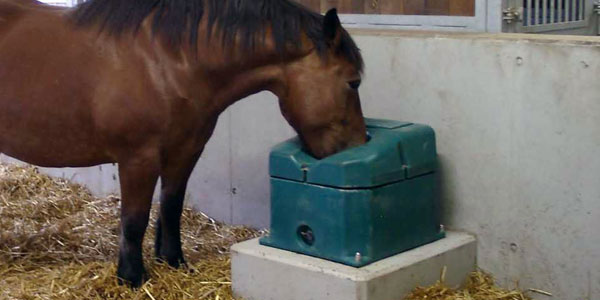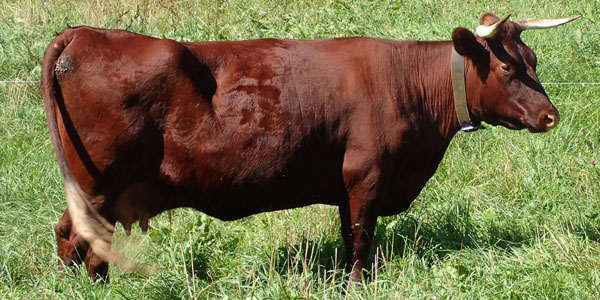
Water Requirements of Horses
Water Requirements of Horses
by Heather Smith Thomas of Salmon, ID
Water is an important ingredient of the horse’s diet, since it is crucial for proper function of the body. This “nutrient” makes up 65 to 85 percent of a foal’s body weight, and about 68 to 72 percent of an adult horse’s body weight. A 1000 pound horse’s body contains about 80 gallons of water. Even small changes in total body water can have a negative impact on a horse’s health and well being. Water is contained within all body cells, between cells, and is an important component of blood, joint fluid and lymph.
IMPORTANCE OF WATER – Water is essential for digestion and waste elimination through the digestive and urinary tracts. The body’s chemical reactions, cellular reactions, transporting of nutrients and wastes, temperature regulation, joint lubrication, shock absorption in body cavities and joints, all depend on water. A horse’s brain is 85 percent water. Muscles are 75 percent water, bones 30 percent. Water cushions the brain and central nervous system, and lubricates all the body’s moving parts. It plays a major role in temperature control, through sweating. On a hot day, a hard-working horse may lose up to 4 gallons of water per hour.
The horse’s stomach holds only 3 to 4 gallons of water – about as much as he will drink at one time when thirsty. It takes about 48 swallows to drink a gallon of water. A 1000 pound horse drinks about 10 gallons of water daily in mild weather, the actual amount depending on his work and the day’s temperature. During 90 to 100 degree weather, the idle horse will drink at least 16 gallons to replace fluid lost through sweat; the working horse will drink much more. With heat and work (or hot weather and lactation), water consumption may exceed 100 gallons a day. Most horses drink only 4 or 5 gallons daily when daytime temperatures drop below freezing, but when temperature gets up into the 50’s or 60’s the idle horse drinks about 12 gallons per day. These are just averages; individual horses may consistently drink more or less than this.
The horse has 4 storage areas in the body for water. His circulatory system holds about 5 percent of his total body fluid – a percentage that can rapidly fluctuate, depending on his needs. About 15 percent of the body’s water surrounds the cells and blood vessels, and up to 50 percent is contained within the body cells (and it can take up to 2 or 3 days to completely replenish water lost from the cells after a horse becomes severely dehydrated). The remaining 30 percent of the horse’s water is stored in the gut, primarily the cecum and large intestine, and about half the water in the cecum can be used to replenish losses elsewhere in the body.
Often the first concern in any disease condition is to make sure the horse has enough body fluid, since dehydration can have serious consequences. Lack of water affects all body functions, and can be caused by the horse not drinking enough, or by excessive water loss. Fever, diarrhea, excessive sweating, and other factors can reduce the body’s water supply. In a very real sense, water is the most important ingredient of a horse’s diet. He can live much longer without food than he can without water. A study in 1982 showed that horses in a warm climate could survive 20 to 25 days without feed, if they had water to drink. But when deprived of water (even though they had plenty of feed), they lived only 5 or 6 days – and stopped eating by the second day. Horsemen and nutritionists generally spend a lot of thought and planning to make sure a horse’s daily requirements for energy, protein, vitamins and minerals are met, yet water is often given little consideration.
FLUID STATUS AND DEHYDRATION – When a horse is short on fluid, the first sign of this imbalance may be colic; water is pulled from the gut to service more important functions. If he continues to be short on water, more serious problems arise. If dehydration is gradual, the most obvious symptom is often decrease in appetite, and impaction; there is little moisture in the digestive tract. Feces become scanty and hard. The horse won’t eat, and passes little manure. To prevent colic and more serious problems, the horseman should make sure a horse has access to plenty of clean, fresh water, and should become aware of early warning signs of dehydration. As a horse ages, his body contains less water, and he becomes even more susceptible to dehydration and impaction colic.
The pinch test can give a clue to the horse’s fluid status. This involves pulling out a pinch of loose skin at the point of the shoulder. Upon release, the skin should snap right back into place immediately. If it takes 2 to 3 seconds to sink down, the horse is moderately dehydrated (there is loss of fluid in and around the tissue cells; the skin is less elastic). If it takes more than 5 to 7 seconds to sink back into place, he’s severely dehydrated.
DAILY REQUIREMENTS – The water requirement for any horse consists of the total sum of water lost to the body, plus the amount of water needed for specific functions such as building body tissues or producing milk. The average adult horse (idle, doing no work) needs 10 to 15 gallons of water per day – and more in hot weather, or when lactating. Much of this daily requirement is obtained by drinking, but part can be supplied by moisture in feeds such as green pasture plants, and water generated in the body or recycled as saliva. An adult horse produces 6 to 7 gallons of saliva daily while eating (from fluid pulled out of the bloodstream) and this moisture later leaves the gut – recycled back into the bloodstream.
Some water is created by the body’s metabolism through the breakdown of carbohydrates and other organic molecules – in chemical reactions that yield water as one of the by-products. Water loss occurs through sweat, evaporation through the skin, in urine, manure, and moisture lost through the lungs while breathing.
The specific water requirements of any horse will be greatly influenced by weather and air temperature, how much the horse is exerting and sweating, and what type of feed is eaten. Lush green grass may be 50 to 90 percent water, while hay may be only 5 to 8 percent water. Water consumption is closely related to dry matter intake, and salt consumption. Nutritionists estimate that the minimum amount of water required by the non-working horse in a moderate environment (not very hot nor cold) is about 1.5 quarts of water per pound of dry matter eaten. The water intake is thus affected by what the horse is eating. Horses eating hay will drink more water than horses consuming a large grain ration and less hay.
In one study, water consumption rose as high as a gallon per pound of dry matter intake when air temperature reached 100 degrees. Lactation increases water requirements of mares 50 to 70 percent above average (many mares secrete 5 to 6 gallons of water daily in milk production); some high-producing mares in hot weather drink more than 100 gallons per day. Horses exerting strenuously in hot weather may lose 8 to 10 gallons or more in sweat; they may lose 5 to 10 percent of body weight in fluid loss. If a horse loses 10 percent of his body water, he’s at risk for digestive disturbances. A loss of 20 percent of body fluid is fatal.
To avoid dangerous water loss in summer, don’t work a horse hard when temperature and/or humidity are high, and don’t withhold water when he’s overheated from exertion. It’s safe to water a hot horse as long as the water is not cold, and as long as he continues exercise after drinking (such as walking him after his work). Ice-cold water may cause intestinal cramping and muscle problems if the horse is standing idle after drinking, with his blood rushing from the muscles to warm the cold water in his gut. Lukewarm water is always safer. Water that sits in a tank out in the sunshine may get too warm, however, and horses will refuse to drink it.
Most horses prefer water below 75 degrees F. (between 60 and 75 degrees, in summer, and above 40 degrees in winter). In hot weather, it’s wise to situate water tanks and tubs in shady areas. In a pasture or paddock, make sure the water sources are located where all horses can have easy access (not in a corner where a bossy horse may keep others away), and have the feeding area well away from the water. If some of the feed is close to the water, the boss horse may eat there, and the lower ranking individuals may be reluctant to go by him to get to the water.
Estimates of how much water a horse needs are only guidelines, since every horse is different. Many factors will influence actual water consumption. One study documented daily water intake of one horse for a year. The wide variation in his consumption (which was a low of 2 gallons and a high of 20 gallons per day) illustrates the fact that there is no set standard. The best situation is to provide easy access to plenty of fresh, clean water at all times, with the water being warmed during severely cold weather.
Horsemen are usually aware that their animals need more water in hot weather or during exertion (to make up for sweat loss) but sometimes fail to make sure horses are drinking enough in cold weather. If the water supply develops a surface of ice, the horse may not drink. Most horses will paw and break the ice, but others are not enthusiastic about drinking cold water. Even if water is readily available, horses usually drink less in cold weather, especially if the water is cold. A sudden cold spell may make a horse refuse to drink, and the abrupt change (the drop in available body fluid) often results in colic. This can often be avoided if water can be kept at an optimum temperature.
EXCESSIVE DRINKING – Some horses drink a lot more water than normal, and excrete the extra fluid as urine. A few diseases create excessive thirst and above-average water consumption, but these are rare. Usually increased water consumption is due to what a horse is eating – dry feeds, high protein feeds (which require more water for processing), or extra salt. Horses on high quality alfalfa hay drink more water than when fed grass hay, because the alfalfa is higher in protein. The kidney excretes the by-products of protein metabolism, so if there is more protein in the diet there is more urine production; the horse drinks more water to flush those byproducts (nitrogen compounds) out of his body. Horses that eat a lot of salt, as some will do when confined and bored, also drink more water to flush the extra salt from the body.
WATER QUALITY – Water should always be clean. Horses may refuse to drink dirty, muddy water, or water with manure in it. Water supplies can be toxic if they contain certain minerals in high concentrations, or too much salt or contaminants. Usually fresh city water, well water, or running creeks and rivers are safer than standing water such as a small pond (which might become stagnant or collect a higher concentration of contaminants). If your water source is questionable, have it tested.




